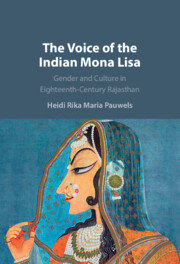Book contents
- The Voice of the Indian Mona Lisa
- The Voice of the Indian Mona Lisa
- Copyright page
- Contents
- Figures
- Acknowledgments
- Note on the Text
- Abbreviations
- Introduction
- 1 The Making of the “Indian Mona Lisa”
- 2 The Queen and the Slave Girl
- 3 Becoming the Prince’s Concubine
- 4 Synergies of the Literary Couple
- 5 Legacy: Self-Fashioning and Its Limits
- Conclusions
- Appendix: Sources
- References
- Index
Conclusions
Published online by Cambridge University Press: 17 August 2023
- The Voice of the Indian Mona Lisa
- The Voice of the Indian Mona Lisa
- Copyright page
- Contents
- Figures
- Acknowledgments
- Note on the Text
- Abbreviations
- Introduction
- 1 The Making of the “Indian Mona Lisa”
- 2 The Queen and the Slave Girl
- 3 Becoming the Prince’s Concubine
- 4 Synergies of the Literary Couple
- 5 Legacy: Self-Fashioning and Its Limits
- Conclusions
- Appendix: Sources
- References
- Index
Summary
This book’s journey has led to the recovery of the voice of an eighteenth-century composer of Classical Hindi-Urdu songs, who started as a slave girl in the zanānā of a small principality in Rajasthan. Beyond the glorified quintessential Kishangarhi “Lady with Veil,” or Portrait of Radha, Banī-ṭhanī was more than just a stylish concubine of the prince who commissioned the famous painting. We have encountered a talented young performer who managed to avail herself of trajectories for social mobility, celebrated for her creative accomplishments by courtiers and monks alike, contributing to the flourish of cultural output in mid-eighteenth century Kishangarh, yet struggling to carve out a place for herself within the hierarchies that framed her world. What broader conclusions has our exploration revealed? A brief overview is followed with more in-depth articulation of the contributions to each of the fields explored in turn.
- Type
- Chapter
- Information
- The Voice of the Indian Mona LisaGender and Culture in Eighteenth-Century Rajasthan, pp. 234 - 250Publisher: Cambridge University PressPrint publication year: 2023

